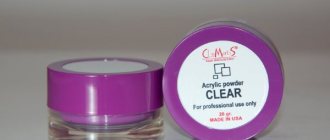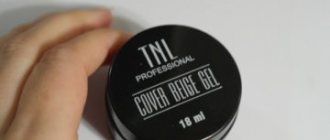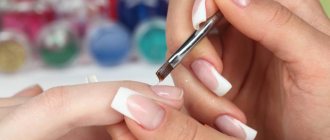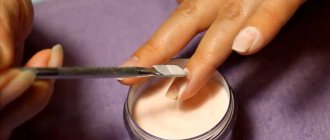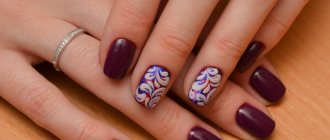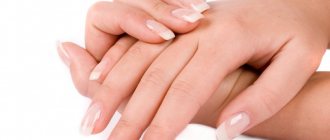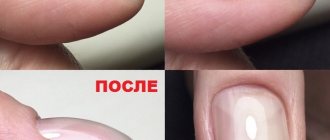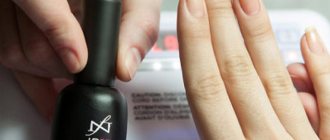Beauty salons offer different types of manicures with bright designs. The most popular are edged or hardware manicures coated with gel polish. It has many advantages: durability, gloss, variety of colors and designs. Unfortunately, not everyone can appreciate all the advantages of this type of coating. Representatives of the fair sex with fragile and brittle nails will not be able to do this, since the varnish often chips. Strengthening nails with acrylic powder helps in this situation. Its advantages are ease of use and no need for special skills.
Acrylic powder will help strengthen brittle nails
What is it, what are the advantages and disadvantages of the material?
Acrylic powder is a crushed synthetic powder that has strengthening properties. Acrylic was first used in dentistry, and only later it gained popularity in the manicure industry.
Penetrating into microcracks along with the gel, acrylic, under the influence of ultraviolet radiation, seals all damage. It strengthens nails and helps in correcting even serious “breakages”. Use it like those whose gel polish does not last as long as it should. Acrylic makes nails harder, so they retain elasticity and break much less.
Acrylic powder does not have a healing effect .
Strengthening is explained by the creation of an additional protective layer. Initially, acrylic powder was used only for extensions. It is quite plastic and, after drying, gains maximum strength. It is these properties that make it possible to use it to “repair” the nail plate, and later to prevent chipping and peeling. The use of the material allows the nails to look natural and maintain strength for a long time. It also does not require specific care.
Nail plates coated with acrylic powder look well-groomed. The powder itself is impossible to notice on the nails. Acrylic masks almost all imperfections, and the reinforcement is completely safe. But it's not all positive aspects. also noted:
- High quality acrylic covers the entire nail plate. The material does not spread and does not harden prematurely. It's quite easy to work with. The powder can also be used to create various designs.
- The material qualitatively strengthens the plates. You can use it without decoration - in itself it looks natural and neat. The powder fills all existing cracks.
- Strengthened nails can easily withstand elevated temperatures and any other loads. They do not soften when kept in water for a long time or when in contact with household chemicals.
- With acrylic, natural nails receive enough oxygen. A vitamin composition can be applied underneath it, which will provide additional strengthening and nutrition to the nails.
- The powder is easily removed. For this, special solutions are used. Since there is no need to file down the top layer, the plate is not damaged.
Despite the fact that acrylic powder has a number of advantages, one cannot fail to note its disadvantages:
- Poor quality powders can lead to an allergic reaction. Failure to comply with the technology can even lead to injuries to the nail plate. For a positive result, it is important to adhere to all the rules.
- The powder hardens quickly, so you need to work with it as quickly as possible.
- The material cannot be used for nail fungus - it can aggravate the course of the disease.
- Strong specific smell. It can cause headaches and malaise. It is important to ventilate the room where you work with acrylic.
- After covering with powder, nails lose their natural shine.
Why do you need additional nail strengthening?
Decorative varnishes do not adhere well to thin nail plates. Using a mixture of acrylic powder and glue:
- an intermediate bonding layer is created between the nail plate and the decorative coating (not only gel, but also ordinary varnishes can be used as it);
- nails become stronger, do not break or peel;
- their surface is leveled.
Mixing acrylic powder with substances called monomers is used to create nail extensions. To repair nails, straighten and strengthen them, it is enough to purchase a special glue and mix it with acrylic powder. It has a more gentle effect and its smell is less pungent. However, it will no longer be possible to model nails and lengthen them using such a mixture. To do this, you should use monomers rather than adhesives.
To repair nails, straighten and strengthen them, just purchase a special glue and mix it with acrylic powder
Advice! To ensure that the overall layer on the nail is not too thick, when covering with acrylic powder, the layer of base varnish should be made smaller.
Indications and contraindications
Indications for strengthening with acrylic are weak nails that often break. It is also recommended to use powder if the gel polish is worn less than expected, peeling, chips, and cracks occur.
The procedure has a number of contraindications:
- allergic reaction to the component;
- the presence of a fungal disease;
- antibiotic treatment;
- undergoing chemotherapy.
What's wrong?
RESPONSIBILITY. RESPONSIBILITY › › ÑвÑÑ Ð¿ RESULTS. RESULTS ´ÐµÑÑелÑноÑÑи - ÑÑа веÑÑ Ð½ÐµÐ¾Ð±Ñодима. RESEARCH ROOM ова Ñой. RESULTS а — он ÑÐ±Ð¸Ð²Ð°ÐµÑ Ð¼Ð¸ÐºÑооÑганизмÑ, живÑÑÐ ¸Ðµ на ногÑе. RESULTS ASSESSMENT, ASSURANCE, ASSURANCE °Ð ¶Ðµ пÑивеÑÑи к поÑÐ²Ð»ÐµÐ½Ð¸Ñ Ð±Ð¾Ð»ÐµÐ·Ð½ÐµÐ¹. RESEARCH, RESULTS µ μ μ μ μ μ ›› ноÑÑÑÑ, а Ð´Ð»Ñ Ð·Ð´Ð¾ÑовÑÑ Ð´Ð¾ÑÑаÑоÑно пÑовеÑÑи об ÑабоÑÐºÑ Ð¿Ð¾ кÑаÑм и Ð²Ð´Ð¾Ð»Ñ Ð±Ð¾ÐºÐ¾Ð²ÑÑ Ð²Ð°Ð»Ð¸ÐºÐ¾Ð².
How to strengthen natural nail plates: step-by-step instructions
Strengthening with acrylic powder is done by manicurists in salons. You can carry out the procedure at home. If you cover your nails with gel polish yourself, this will not be a problem for you. But it is important to follow the instructions to avoid detachments and layers. The procedure consists of several steps. Prepare tools and materials in advance:
- manicure set;
- cuticle products;
- dehydrator;
- abrasive sticks and buffs;
- antiseptic;
- primer and bonder;
- acrylic Powder;
- brush to remove dust;
- modeling gel or colored gel polish;
- base and top coat;
- lamp (LED or UF);
- orange sticks;
- lint-free wipes.
Preparation
- Before starting the procedure, it is important to treat all instruments, hands and nails with an antiseptic.
This is a significant stage that should not be ignored. Gel polish lasts quite a long time and even a minimal infection, once under the coating, can cause the proliferation of harmful microorganisms. Many troubles can be transmitted through poorly disinfected instruments. It is necessary to carry out disinfection even if you use the tools only for yourself. - Nails need to be given the desired shape and a hygienic manicure done. Remove the cuticle, push it back and clean the nail plate from the pterygium (this is the name of the area in front of the cuticle). Please note that improper nail treatment is the most common cause of coating peeling.
- Afterwards the nail is polished with a buff or a soft file. The resulting dust is cleaned with a brush. At this stage, it is important to eliminate the gloss so that the gel sticks better without causing cuts.
How to apply primer?
After you have sanded your nails and brushed them, you need to degrease them. To do this, wipe the nails with a cotton pad soaked in a dehydrator or degreaser. The primer must be applied to the entire nail plate. It prepares the nail for further work, evens out the water balance and eliminates excess moisture. The primer also improves the adhesion of the plate to the artificial turf.
An acid-free primer is better suited for home use.
To improve the result, you can additionally apply a bonder. It should dry well. This product prevents peeling of materials. It is denser and similar to glue, which is why it is called “double-sided tape.” Thanks to the gel structure, the bonder is distributed evenly, but it is important that it does not flow. It is also recommended to “seal” the edges of the nails with a bonder.
If you use both products, apply the primer before the bonder. Some of the bonders dry exclusively under a lamp, so in each case you need to follow the manufacturer's instructions.
Although both drugs are aimed at improving grip, their effects are somewhat different:
- Thanks to the primer, a film is formed that protects the nail from penetration of chemicals into further layers. Its tasks also include cleaning, disinfection, degreasing, and adjusting the pH balance.
- Bonder is elastic. It bonds the layers together to the maximum, preventing detachments and cracks.
In view of this, you should not choose between the means - they act differently and are not a replacement for each other. You don’t have to use them at all, limiting yourself to filing and degreasing the nail. But if the durability and aesthetics of a manicure are important, it is still better to apply both a primer and a bonder.
Base layer
In order to strengthen the nail, it is better to use thick silicone consistencies or rubber bases.
- The base layer is applied immediately after the primer or bonder has dried. To distribute the base evenly, it is recommended to apply the first layer onto four fingers and dry it. This is done on both hands alternately.
- Then apply the base separately to your thumbs. Due to this, it will be more convenient for you to dry your nails, and the gel will not run off. Make sure that during the application process the coating does not affect the cuticle or skin on the sides of the nail - this can lead to detachments.
If the gel leaks, you can carefully remove it with an orange stick.
Acrylic
- Acrylic powder must be applied to the base or shellac before the last layer dries. Immediately after painting your nails, sprinkle them with a thick layer of acrylic powder. It is important not to leave empty spaces.
- You can sprinkle the entire nail or just problem areas - the center and sides. You can also simply dip your nail into the powder and then tap the edge with your finger to release any excess powder. You need to dry the coating under ultraviolet light for a couple of minutes.
- Remove excess with a brush. If the surface is uneven, it is sanded.
Fixation with base coat or gel polish
When the acrylic hardens, the nail is covered with gel polish in one or two layers. Each layer must be dried in an ultraviolet lamp.
If you used acrylic only for strengthening, without covering the nail with colored gel polish and decor, then after application, fix it with a base layer and then use a finish. The top coat also needs to be dried in a lamp. Its task is to protect the nail plate from ultraviolet radiation and create a glossy shine. The finish can be applied in one or two layers.
If a sticky layer remains after finishing, then after drying it must be removed with a cotton pad soaked in a degreaser. An alternative is nail polish remover that does not contain acetone.
Features of the training course
Nail design courses with gel polishes last for 12 hours. During this course you will learn how to apply various designs in the design style, master painting techniques with brushes, including how to correctly use primary colors without violating the rules of color and creating unique compositions. Nail design courses are conducted in small groups in order to provide an almost individual approach to each student. The lecturers have extensive experience in the field of teaching manicure, pedicure and nail extensions, in particular painting, and personal long-term work experience, so the courses are held in the form of transferring their own knowledge and skills.
Class time varies and is adjusted to the capabilities of all group participants; the course of nail design with varnish and training can be selected individually. By agreement, we can conduct both courses in artistic nail painting and all available courses with a visit to your salon, which can be located in any city in Russia.
How often to repeat the procedure?
The cementing properties of acrylic double the wear time of a manicure . With it, you will not need to correct your gel polish more often than once every 3-4 weeks. Accordingly, acrylic powder should be used with the same frequency. When performed correctly, the procedure will prevent chipping and peeling.
You should not overextend your nails, especially long ones. As the nail grows, the free edge becomes heavier, and the plate at the base remains unprotected and becomes vulnerable. The “center of gravity” shifts, which increases the likelihood of damage.
Removing the coating
Removing acrylic is no less important a procedure than applying it. This requires a special liquid. The procedure goes as follows:
- First, trim the raised areas of your nails. This must be done as carefully as possible, otherwise part of your own nail may break off.
- Then the finishing gel is removed with a large file. This is a rather complicated process, so be prepared to work hard.
- Soak a cotton pad in the removing liquid and apply it to the nail, then wrap it in foil. This is done with all fingers. Wait 10 minutes.
Thanks to this procedure, acrylic becomes soft and pliable. It can be easily removed with a simple nail file.
What is better to use in the salon and at home: acrylic or gel?
The main alternative to acrylic powder is strengthening nails with gel or biogel. Gel and biogel include resin from coniferous trees. It does not provoke allergies and is often included in antifungal agents. The advantage of these materials is that they are easier to apply.
Acrylic powder has a more pronounced positive effect on fragile nails. This is an excellent material that makes it possible to strengthen the nail plate quickly and effectively. But working with it is more difficult than with gel and biogel, so it is important to first familiarize yourself with all the intricacies.
Strengthening your nails with acrylic powder helps increase the wear time of gel polish and grow long, strong and healthy nails without extensions. The material can be used both in salons and at home. But in any case, try to adhere to all the rules for its use.
Drawings with acrylic powder over gel polish
So even a small jar of powder weighing 21 g will last you a long time; you can use it to create the most unusual three-dimensional designs:
- after drying the shellac in a UV lamp, any patterns are drawn on the nails with a thin brush;
- to obtain drawings, you can also use ready-made templates, which are sold in any store that sells products for nail art;
- without waiting for the gel to dry, carefully dip your finger into a jar of powder;
- its excess is removed with a clean brush;
- the nail is dried in a UV lamp;
- You can decorate all the nail plates with patterns, or decorate only a few nails with them.
To obtain drawings, you can also use ready-made templates, which are sold in any store that sells products for nail art.
Advice! To prevent expensive powder from spilling onto the table, place a sheet of paper under the jar or place it on a small saucer.


